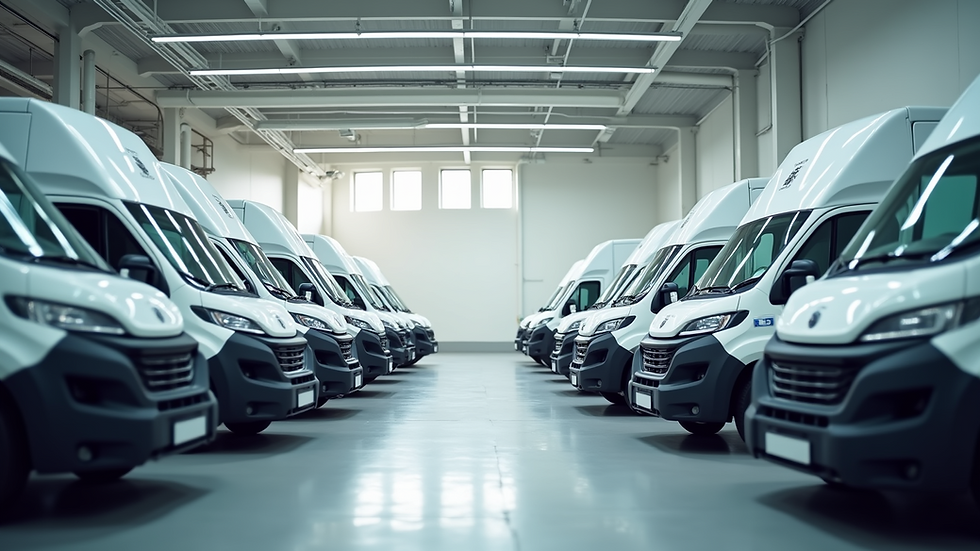Effective Strategies to Reduce Carbon Footprint
- kevindempse0
- Aug 28
- 3 min read
In today’s world, managing transport and operational emissions is more critical than ever. Businesses across sectors such as media, healthcare, manufacturing, motorsport, and logistics face increasing pressure to adopt sustainable practices. By implementing effective strategies to lower carbon emissions, companies can not only contribute to environmental preservation but also reduce operational costs by up to 30%. This post explores practical, actionable steps that organisations can take to achieve these goals.
Understanding the Importance of Lower Carbon Emissions in Business Operations
Lowering carbon emissions is not just an environmental responsibility; it is a strategic business decision. Transport and logistics often represent a significant portion of a company’s carbon footprint. By focusing on reducing emissions, businesses can improve efficiency, comply with regulations, and enhance their brand reputation.
One of the first steps is to assess current emissions levels. This involves measuring fuel consumption, vehicle efficiency, and operational practices. Once we understand where emissions are highest, we can target those areas for improvement.
For example, switching to alternative fuels or electric vehicles can drastically cut emissions. Additionally, optimising routes and improving vehicle maintenance can enhance fuel efficiency. These changes often lead to cost savings, making sustainability a win-win scenario.

Practical Approaches to Lower Carbon Emissions in Fleet Management
Fleet management plays a crucial role in reducing emissions. Here are some effective strategies that businesses can implement:
Adopt Alternative Fuels
Using biofuels, compressed natural gas (CNG), or electric power can significantly reduce greenhouse gas emissions. These fuels produce fewer pollutants compared to traditional diesel or petrol.
Implement Telematics and Route Optimisation
Advanced telematics systems provide real-time data on vehicle performance and driver behaviour. This information helps in planning the most efficient routes, reducing idle times, and encouraging eco-friendly driving habits.
Regular Vehicle Maintenance
Well-maintained vehicles run more efficiently and emit less pollution. Regular checks on tyre pressure, engine tuning, and brake systems are essential.
Driver Training Programmes
Educating drivers on fuel-efficient driving techniques, such as smooth acceleration and braking, can lower fuel consumption.
Invest in Lightweight Materials
Reducing vehicle weight through lightweight materials can improve fuel economy.
By combining these approaches, businesses can make a substantial impact on their carbon emissions while improving operational efficiency.

How to reduce carbon footprint as a student?
Students can also play a vital role in promoting sustainability and lowering carbon emissions. Here are some practical ways students can contribute:
Use Public Transport or Carpool
Opting for buses, trains, or shared rides reduces the number of vehicles on the road.
Adopt Active Transport
Walking or cycling for short distances not only lowers emissions but also promotes health.
Reduce Energy Consumption
Turning off lights and electronics when not in use, and using energy-efficient appliances, helps reduce overall carbon output.
Support Sustainable Products and Practices
Choosing eco-friendly products and encouraging recycling can make a difference.
Engage in Awareness Campaigns
Students can organise or participate in initiatives that promote environmental responsibility within their communities.
These actions, while small individually, collectively contribute to a significant reduction in emissions and foster a culture of sustainability.

Leveraging Technology and Innovation to Support Sustainability Goals
Technology is a powerful ally in the quest to lower carbon emissions. Innovations in vehicle design, fuel alternatives, and data analytics enable businesses to operate more sustainably.
Electric and Hybrid Vehicles
These vehicles produce fewer emissions and are becoming increasingly affordable and practical for commercial use.
Alternative Fuel Technologies
Hydrogen fuel cells and biofuels offer promising options for sectors where electrification is challenging.
Data Analytics and AI
Using data to monitor and predict vehicle performance helps optimise operations and reduce waste.
Smart Infrastructure
Charging stations, smart traffic management, and connected vehicles contribute to smoother, greener transport networks.
Investing in these technologies not only supports environmental goals but also positions businesses as leaders in innovation and sustainability.
Building a Culture of Sustainability Within Organisations
Sustainability should be embedded in the company culture to ensure long-term success. Here are some ways to foster this mindset:
Set Clear Sustainability Targets
Define measurable goals for emissions reduction and communicate them across the organisation.
Engage Employees
Encourage staff participation through training, incentives, and recognition programmes.
Collaborate with Partners
Work with suppliers, customers, and industry groups to share best practices and drive collective impact.
Monitor and Report Progress
Regularly track performance and transparently report results to stakeholders.
By making sustainability a shared responsibility, businesses can create lasting change and improve their overall resilience.

Moving Forward with Confidence and Commitment
Reducing emissions is a journey that requires commitment, planning, and continuous improvement. By adopting practical strategies such as alternative fuels, efficient fleet management, and embracing technology, businesses can achieve significant environmental and financial benefits.
We encourage you to explore ways to reduce carbon footprint within your operations. Together, we can build a more sustainable future while enhancing efficiency and reducing costs. The path to net-zero emissions is clear, and with steady, informed steps, it is entirely achievable.





Comments